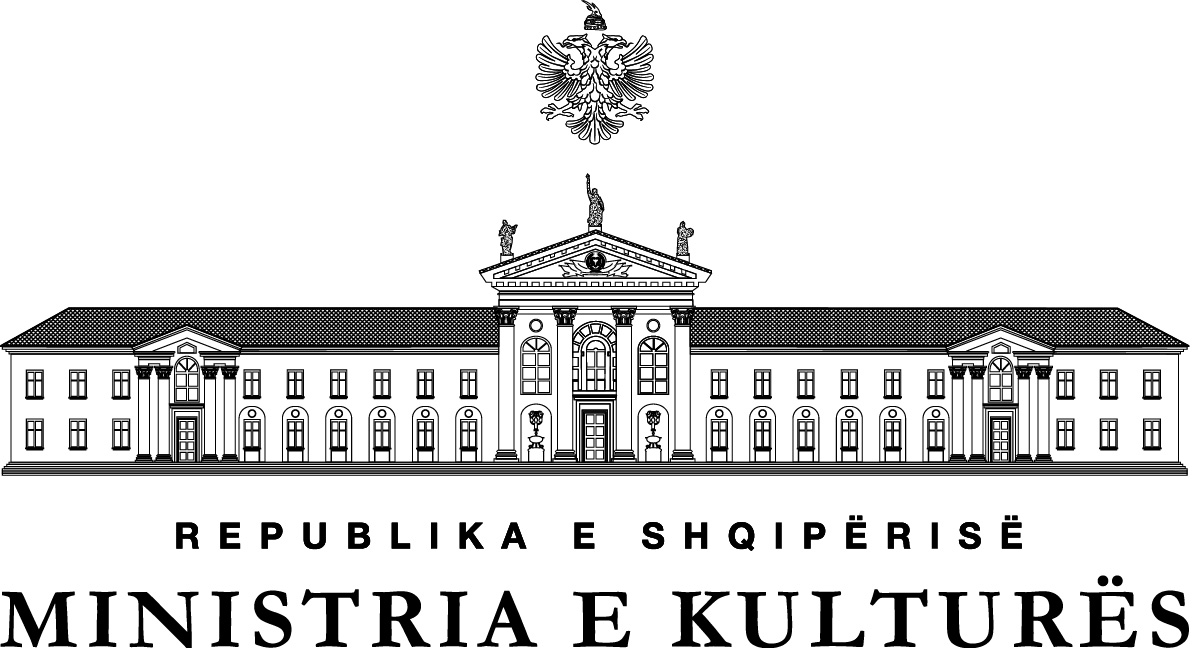
presents ten new texts written by contemporary writers and thinkers on the architecture of displacement. These texts have been set to music and sung by some of the last remaining groups of Albanian iso-polyphonic singers, an art form now protected as “intangible cultural heritage” by UNESCO.
A living art form in step with generations of migration and transition, “singing migration” has been a core part of processing departure, longing, and return. The Albanian Pavilion is a space of collective listening, of “individuals in company.”
I Have Left You The Mountain initiates a conversation about the urbanism of displacement, projecting the Albanian case onto an international stage, with the express intention to transmit that dialogue and its speculations back into Albania.
Contributors
Etel Adnan
Mourid Barghouti
Michel Butor
Claire Fontaine
Yona Friedman
Anri Sala
Michael Taussig
Yanis Varoufakis
Ornela Vorpsi
Finn Williams
The singers of Fier
The singers of Vlorë
The singers of Himarë
The singers of Tirana
Etel Adnan is a poet and a painter. Born in 1925, she was raised in Beirut. Her mother was Greek from Smyrna, her father, Ottoman born in Damascus. In Lebanon, she was educated in French schools. She studied philosophy at the Sorbonne, and later studied at UC Berkeley and Harvard University. She lives in Paris.
Mourid Barghouti is a Palestinian poet. He was born in 1944 in Dair Ghassana near Ramallah. He was studying English literature at Cairo University when Israel occupied eastern Palestine in 1976 and was denied return to his homeland; he has since lived in exile. His autobiographical narrative I Saw Ramallah (1997) won the Naguib Mahfouz Award for Literature (1997), followed by I Was Born There, I Was Born Here (2009). In 2015 he was the Chair of the International Prize of Arabic Fiction.
Michel Butor is a writer and essayist. Born outside of Lille in 1926, he studied at the Sorbonne and subsequently taught in Manchester and Thessaloniki, among other places. Combining the poetic with the analytical, his works—including L’emploi du temps (1956; Passing Time), La modification (1957; Second Thoughts), and Le génie du lieu (1958; The Spirit of Mediterranean Places)—often explore movement, time, and place.
Claire Fontaine is a Paris-based collective artist, founded in 2004. After lifting her name from a popular brand of school notebooks, Claire Fontaine declared herself a "readymade artist" and began to elaborate a version of neo-conceptual art. Working in neon, video, sculpture, painting, and text, her practice can be described as an ongoing interrogation of the political impotence and the crisis of singularity that seem to define contemporary art today.
Yona Friedman is an architect and theorist. Born in 1923 in Hungary, after serving in the Resistance, Friedman migrated to Israel, where he developed basic yet radical forms of architecture made from prefabricated elements. In 1960, Friedman published his two seminal manifestos, L’architecture mobile and Ville spatiale. He later moved to Paris, where he is currently based.
Anri Sala is an artist. Born in 1974 in Tirana, he studied painting at the National Academy of Arts in Tirana, after which he continued to study in Paris and in Tourcoing. His video and installation works explore language and memory, the construction of narrative, and the space between the visual and the aural. He lives and works in Berlin.
Michael Taussig is an anthropologist. Born in Sydney, he is based at Columbia University in New York. He is the author of many books including Shamanism, Colonialism, and the Wild Man (1987), Defacement: Public Secrecy and the Labor of the Negative (1999), and What Color Is the Sacred? (2009).
Yanis Varoufakis is an economist, and is the former finance minister of Greece. Born in Athens in 1961, he studied in Essex and Birmingham, and has taught in Athens, Austin, and Sydney, among other places. He is the author of numerous books including The Global Minotaur: America, the True Causes of the Financial Crisis and the Future of the World Economy (2011) and And the Weak Suffer What They Must? Europe, Austerity and the Threat to Global Stability (2016).
Ornela Vorpsi is a novelist and artist. Born in Tirana in 1968, she studied in Tirana, and later in Milan and Paris. Her published work includes, among others, the photographic monograph Nothing Obvious (2001), Il paese dove non si muore mai (2005; The Country Where No One Ever Dies), and Bevete cacao Van Houten! (2005; Drink Van-Houten Cocoa!). Tu convoiteras (2014), is the first she has written in French; she lives and works in Paris.
Finn Williams is an architect-turned-urban planner. He studied in Glasgow, Porto, and London. He is Regeneration Area Manager for North West London at the Greater London Authority, and curator of the British Pavilion at the 15th International Architecture Exhibition of La Biennale di Venezia.
Fier
Petrit Canaj
Llazar Dumi
Kastriot Halihoxha
Nesim Meno
Muharrem Mezani
Guri Rrokaj
Fatmir Tahiraj
Shaban Zeneli
Vlorë
Organized by Sejmen Gjokoli
Adriatik Cenko
Viktor Gjoka
Sinan Gjoleka
Vendim Kapaj
Piro Latifaj
Dejrim Mustafaraj
Trifon Malaj
Himarë
Organized by Kristo Çipa
Luljeta Çipa
Valentina Gerdhuqi
Violeta Gerdhuqi
Zaharulla Koka
Polite Merkuri
Eglanda Prifti
Vojsava Zenelaj
Tirana
Dhurim Ballo
Sotir Ballo
Nazo Celaj
Trifon Golemi
Hyso Xhaferraj
The Albanian Pavilion
at the Venice Arsenale
Commissioner
The Ministry of Culture of the Republic of Albania
Curators
Simon Battisti
Leah Whitman-Salkin
Åbäke
Sound design
and technical consultation
Peter Meanwell
Trond Lossius
Furniture design
Max Lamb
Pavilion construction
Luigi D'Oro & Arguzia S.r.l.
Location
Arsenale (Room 5), Venice
Press opening
26 May 2016, 17:00
Record launch
26 May 2017, 18:30 @ BRUNO
Opening hours
26–27 May 2016 (vernissage), 10:00–19:00
28 May–27 November 2016: Tuesday–Sunday, 10:00–18:00
28 May–24 September 2016: Friday–Saturday, 10:00–20:00
Closed on Mondays (except 30 May, 5 September, 31 October, 21 November 2016)
The Architecture of Displacement
The second floor façade of Paris Night Club features a giant guitar that whirls upward from what appears to be a chrome subway station entryway. It sits above Coco Chanel Bar & Wine, a quiet café decorated in synthetic fabrics and its namesake logo. One block south, American Computer Service, Kiev Dental, and Paris Perfumery share a storefront. All are located in Komuna e Parisit (Paris Commune), a relatively new neighborhood of Tirana, Albania. These façades belong to an attitude, and a city, with a particular historical relationship to the “outside,” or jashtë.
Appropriating visual identities from the West, in the way Paris Night Club does, was once illegal in Albania. During most of the Albanian communist party’s forty-six-year rule, images of and from the outside were forbidden. Today the process of undoing that isolation can be seen throughout the city. This process also occurs in personal identity—experience of the outside has become the defining basis of social status, and is communicated in dress and worldview. One who does not have this knowledge feels the disadvantage concretely; hireability can hinge on the social skills of a postcommunist identity. The private spaces of the city, in homes and in businesses, offer environments that deliberately counter communist Albanian tropes, always striving to be associated with the outside.
In 2013, 43 percent of all Albanian nationals lived abroad. Migration has real emotional and psychological consequences. For sociologist Abdelmalek Sayad, migration produces a “double absence” in the social universe of the migrant. In the host country, the migrant is an unaccepted outsider, while back home, the experience of the outside has brought a worldliness, and perhaps a new wealth, that puts them at odds with those they left behind. For the doubly absent migrant, home and identity become manifest “in between.”
In contemporary urban Albania though, the experience of migration is by now so widespread that it has ceased to cause alienation. Many people from the first big wave of migrants in the early 1990s—primarily men of working age—are now in their sixties. After twenty-five years of open borders, urban culture has thoroughly adjusted to this condition of in-between-ness. The generation of Albanians that has grown up in the “open” era, even those who haven’t lived abroad, has fully embraced the identity of a kind of borderless internationalism. They speak multiple languages, are largely secular, and consider themselves to be part of a fluid contemporary European youth.
The concentration of this borderless mentality has visible tangible effects on the city. In one sense, to focus one’s gaze outside would seem to come at the expense of the local—an emotional disconnection from one’s immediate surroundings can produce an ambivalence about the broader urban space. That ambivalence is only compounded when the city changes as quickly as it does here. If your street is torn up again and again, place loses its bearings. Transition, in its brutal speed, leaves little room for attachment. Albanian urbanism has evolved haphazardly, through radical political shifts, without stewardship but with a common value: the desire to be legibly, generically, not here.
During the “wild” years of the 1990s, much of the new construction in Albanian cities was unneeded and overscaled. New buildings crowded the urban space, disabling old infrastructure by blocking drainage and rerouting streets. During the rainy season, overbuilt cities flood suddenly because these buildings have been constructed on top of the former storm water collection system. Densities of buildings and people no longer correspond to history. There is a shared sentiment in Albania that cities here have been “ruined.” Sarandë, once the jewel of the south, “ruined”; Durrës, the main port city, formerly lined in pine trees and now lined in high-rises, “ruined.” This sentiment holds that Albanian cities can never return to their past, orderly state. Therefore, one focuses elsewhere.
There is an ironic paradox in this belief: the built material that belongs to communism is a largely unwanted reminder of the past, but at the same time, cities have been irrevocably ruined by the new. In this view, the feelings of disappointment and claustrophobia with which residents describe Albania’s urban space can be understood in their full depth.
Recently, Tirana and other Albanian cities have witnessed a spate of “reparative” demolition undertaken by the government. This demolition leaves performative, disciplinary scars across scales: one wakes up to discover their regular fruit vendor no longer there, her small overhang now a pile of rubble; but also large communities of Roma and Egyptians displaced by “beautification” efforts. In the rush of transition, Tirana and other Albanian cities often delete the present. History never takes root, and in turn, identity remains in flux.
The collective preference for the visual and spatial forms of “not Albania,” combined with a discontentment with the diffuse control of urban space, has created a European city that defies an obvious identity. Contemporary urban Albania stands in stark contrast to Renaissance values like continuity and deference to historical form, which still very much govern most European cities. Tirana must be the least didactic capital city in Europe.
The city is a receptor and mirror of that identity of displacement, distracted and self-interested—late to capitalism but just in time for late capitalism. For the doubly absent migrants of previous generations, to look inward at self and city might seem like staring into a void. But in Albania, Sayad’s migrant has its reflection in an entire city. Tirana is no void; rather it represents a rich urbanism, wearing layers of psychological processing on its sleeve.
Places like Paris Night Club or Coco Chanel Bar & Wine seem to change hands on a nearly weekly basis. Yet the city’s residents’ own emotional relationship with place makes no demands for continuity. The ironic paradox of the Albanian urban dweller keeps the city always displaced, always becoming.
Simon Battisti is an architect and teacher based in Tirana, Albania; Leah Whitman- Salkin is an editor based in Tirana, Albania; together with Åbäke they are the curators of the Albanian Pavilion at the 15th International Architecture Exhibition of La Biennale di Venezia.
Essays
The Comfort of Sound
in a World of Absences
The Architecture of Displacement
The Comfort of Sound
in a World of Absences
When I arrived in the southern Albanian port town of Vlorë for my first fieldwork, I was warned that I should refrain from eating fresh fish. The fish, according to local lore, could have fed on the remains of drowned Albanians who died trying to reach Italy by crossing the Strait of Otranto. Known as the “Tragedy of Otranto,” the collision of an overcrowded ship with an Italian naval vessel on March 28, 1997, left between fifty-seven and eighty-five migrants dead; a misfortune of antique dimensions. But Otranto was just the tip of an iceberg of alarming statistics by demographers, economists, and politicians, who constated an unprecedented brain drain. Migration scholars exulted over this “laboratory of migration,” where the development of an isolated communist regime with heavily restricted mobility to a country with open borders could be observed in acceleration under a looking glass. But these figures and the idea of a “migration incubator” deprived migration of its deeply human dimension. On the one hand, this large scale demographic experiment produced disrupted continuities, broken friendships, and destroyed family lives; on the other hand, migration nourished hopes for a better life and generated economic success stories and remittances, which became prominently visible across the country. Today, almost every Albanian has a “living dead” in their family, and throughout history people have mourned them me zë—with the human voice.
Even before World War II, kurbet, labor migration to the interior Ottoman Empire and later to Romania, the United States, Australia, and Argentina, had generated rituals that involved a distinctive phonosphere. Mothers, fathers, sisters, and brothers met at the edge of villages to see off their relatives: in front of the old church, under a pear tree, near the stone bridge, on a rock whose surface was eroded by mothers’ tears, they would sing, sigh, weep, lament those who left for the unknown. Singing—making oneself heard, affirming social ties, and evoking a sense of local pride—has been a way of building hope into the void, of making the “imagined community” last beyond borders, beyond the world of the known.
Singing was a way to communicate in a world where letters or the accounts of those who returned were the primary source of information. Both those who left and those who remained tried to bridge the gap of silence, of the unsaid, through encoding it in song. This sonic world bridged the worlds of absence and of presence; it constructed a virtual image of those who had departed. It allowed for a resonance between the voices of those who were uprooted and separated and those who were in search both of a new physical and a new spiritual home.
This “translation” of absence through song is called këngë kurbeti, migration song. Its drone-based polyphonic form is prominent south of the river Shkumbin—in an area that includes Vlorë and other villages from which thousands of Albanians have left their motherland. These songs, which are part of a shared Mediterranean polyphonic tradition, are unique in their vitality as a life-affirming everyday practice and in their surviving modes of transmission, a fact that was acknowledged prominently when UNESCO proclaimed “Albanian folk-iso polyphony” a “masterpiece of oral and intangible heritage of humanity” in 2005. Such songs show the relevance of locally rooted traditional practice—particularly in the age of globalized media networks— in commenting and making sense of the present, continuously transforming an inherited vocal practice. Any such performance is marked by a “sharing of pain” between singers and their audience. The authority of the singer is constituted by the way he or she manages to emotionalize the audience and to transmit mall, a multifaceted emotional state of social, spatial, and sonic nostalgia.
Participation in singing and listening to këngë kurbeti is contingent on a personal, lived experience of migration. This direct experience grants the audience access to the musical world of the singers; it enables them to decipher sonic markers and their message. The phonosphere of such migration songs is often created and improvised in the very moment of performance. I have witnessed this during concerts when singers and audiences have broken out in tears, or when spectators have suddenly joined in with the singing group, recalling their own migration experiences through song.
Many of these sounds are the same we know from funerals: sighs, cries, leaps into the head register, piercing shrieks. Some of them recall the natural soundscape of the Albanian mountains: the cuckoo, the howling of the wolf, or the bleating of a goat. It is an untamed world of natural sounds that becomes tamed and smoothened in a multipart structure with clearly attributed roles and hierarchies: the one who takes (first voice), the one who cuts (second voice), the one who throws (the trembling third voice), the one who holds iso (drone voice). While the first three voices are performed solo, require particular vocal skills, and provide the melodic pattern and the basic textual message of the song, the drone voice is a much more inclusive structural element. It is an element of support—both in the musical sense and in a wider psychological meaning. The iso singers intonate the vowels of the leading voices in an act of collective reinforcement; they share the emotional weight of the text the same way as the village community shares the pain with those individuals touched by the heavy burden of migration. The drone traditionally requires at least four singers who adapt their vocal timbre to each other in what we might call a process of social and musical fine-tuning. The ideal for such a voice is the total merging of and immersion in sound—the formation of a “sonic community.” The drone voice invites those who listen to join in, to solidarize with what is sung and thought, and to make the text resound.
Today, migration is omnipresent in Albania: half-finished two-story houses built at urban peripheries, nourishing the myth of return; cafés called “Schengen”; even gas stations or bus companies named “Emigranti.” This migration was and is portrayed in mass media as an exodus with biblical dimensions—a “media event” constructed and made public through the evocative power of images. This focus on the visual senses, on making visible human tragedy and suffering, however, ignores the fact that in Albania migration is a multisensory phenomenon that calls on our sense of hearing as well.
Listening to a lamentation song makes us understand the agency traditional cultural practice has in processing human uprooting, from ancient times to the present day. It makes us understand that even if our senses are already poisoned, and if the fish from the sea become unswallowable, there is still an intact realm of sounds that is able to give a shelter of hope to those who departed, those who stay, and those who feel with them.
Eckehard Pistrick is an ethnomusicologist based at Martin-Luther-Universität Halle-Wittenberg; he is author of Performing Nostalgia: Migration Culture and Creativity in South Albania (2015).
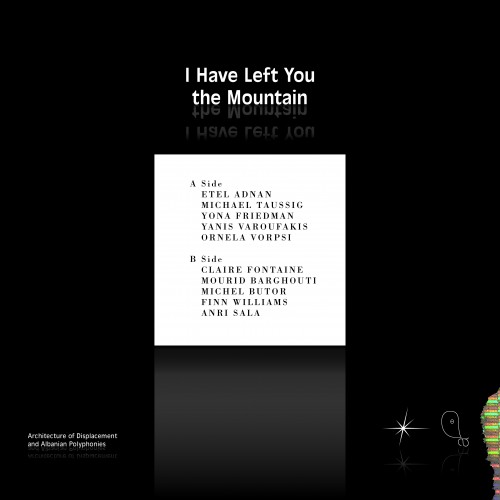
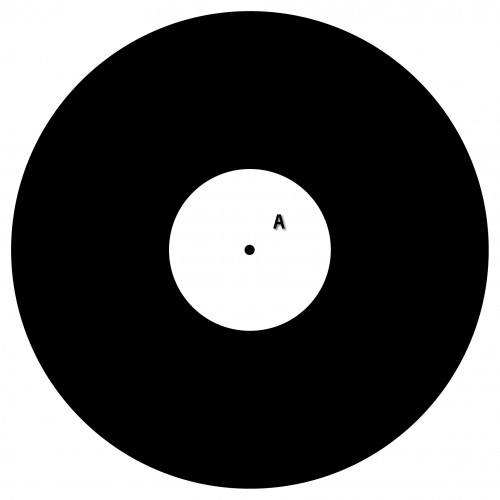
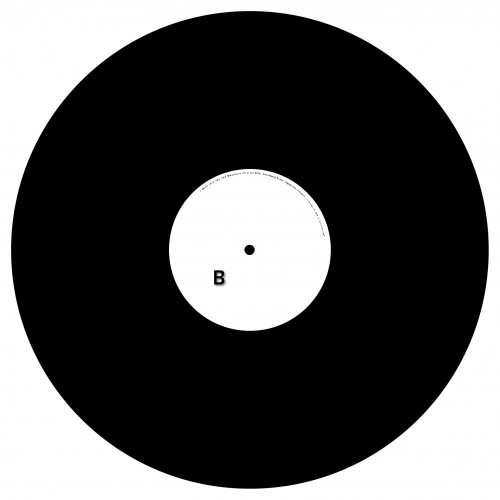
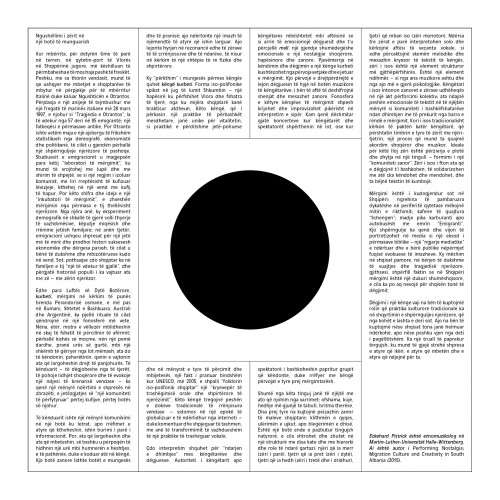
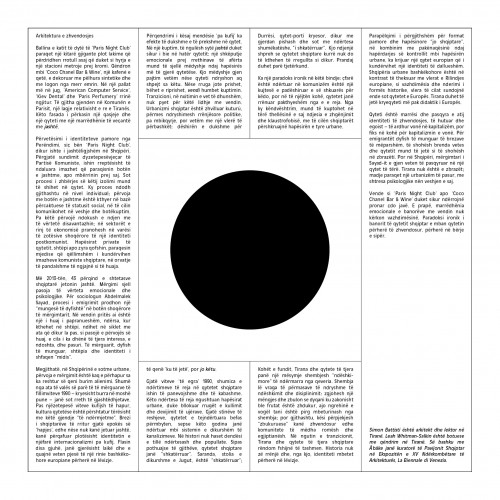
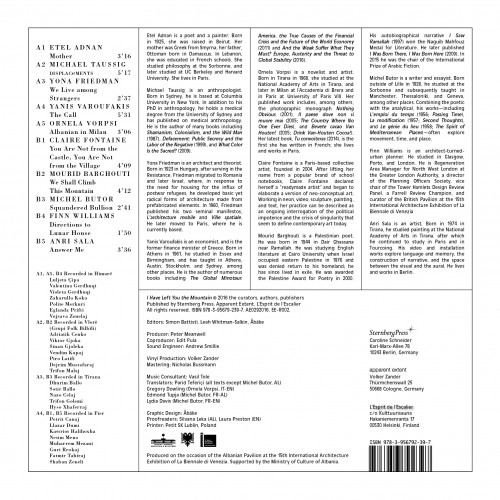
Record & Book
12-inch vinyl with twenty-four page book copublished by Sternberg Press, Apparent Extent, L’Esprit de l’Escalier
Editors
Simon Battisti
Leah Whitman-Salkin
Åbäke
Producer
Peter Meanwell
Coproducer
Edit Pula
Sound engineer
Andrew Smillie
Vinyl production
Volker Zander
Mastering
Nicholas Bussmann
Music consultant
Vasil Tole
Sternberg Press
Caroline Schneider
Karl-Marx-Allee 78
10243 Berlin
Germany
Apparent Extent
Volker Zander
Thürmchenswall 25
50668 Cologne
Germany
L’Esprit de l’Escalier
c/o Kulttuurisauna
Hakaniemenranta 17
00530 Helsinki
Finland
Reference
ISBN 978-3-95679-239-7
AE029 2016
EE-R002
M.I.A.
Borders
Freedom, I'dom, Me'dom
Where's your We'dom?
This world needs a brand new re'dom
We'dom—the key
We'dom the key'dom to life!
Let's be 'dem
We'dom smart phones
Don't be dumb!
Borders (What's up with that?)
Politics (What's up with that?)
Police shots (What's up with that?)
Identities (What's up with that?)
Your privilege (What's up with that?)
Broke people (What's up with that?)
Boat people (What's up with that?)
The realness (What's up with that?)
The new world (What's up with that?)
Am gonna keep up on all that
Guns blow doors to the system
Yeah fuck 'em when we say we're not with them
We're solid and we don't need to kick them
This is North, South, East and Western
Guns blow doors to the system
Yeah fuck 'em when we say we're not with them
We're solid and we don't need to kick them
This is North, South, East and Western
Queen (What's up with that?)
Killing it (What's up with that?)
Slaying it (What's up with that?)
Your goals (What's up with that?)
Being bae (What's up with that?)
Making money (What's up with that?)
Breaking internet (What's up with that?)
Love wins (What's up with that?)
Living it (What's up with that?)
Being real (What's up with that?)
Guns blow doors to the system
Yeah fuck 'em when we say we're not with them
We're solid and we don't need to kick them
This is North, South, East, and Western
Guns blow doors to the system
Yeah fuck 'em when we say we're not with them
We're solid and we don't need to kick them
This is North, South, East, and Western
We representing peeps, they don't play us on the FM
We talkin' in our sleep, they still listen on a system
We sittin' on a stoop
Where we get a scoop
This is how we keep it cool
This is how we do
We representing peeps, they don't play us on the FM
We talkin' in our sleep, they still listen on a system
We sittin' on a stoop
Where we get a scoop
This is how we keep it cool
This is how we do
Egos (What's up with that?)
Your values (What's up with that?)
Your beliefs (What's up with that?)
Your families (What's up with that?)
Histories (What's up with that?)
Your future (What's up with that?)
My boys (What's up with that?)
My girls (What's up with that?)
Freedom (What's up with that?)
Your power (What's up with that?)
Guns blow doors to the system
Yeah fuck 'em when we say we're not with them
We're solid and we don't need to kick them
This is North, South, East, and Western
Guns blow doors to the system
Yeah fuck 'em when we say we're not with them
We're solid and we don't need to kick them
This is North, South, East, and Western
We representing peeps, they don't play us on the FM
We talkin' in our sleep, they still listen on a system
We sittin' on a stoop
Where we get a scoop
This is how we keep it cool
This is how we do
We representing peeps, they don't play us on the FM
We talkin' in our sleep, they still listen on a system
We sittin' on a stoop
Where we get a scoop
This is how we keep it cool
This is how we do
Gonna keep up on all that
Gonna be doing it like that
M.I.A.
Borders
Recorded in Himarë
M.I.A.
Kufij
Lirí, UNË’rí, MUA’rí
Ku e ke NE’rí?
Kësaj bote i duhet Ri’rí sërish
NE’rí – çelësi,
NE’rí çelës’rí në jetë!
Le të jemi ata
NE’rí smart fonë
Mos rri si guak!
Kufij (Ça bëhet me këtë?)
Politika (Ça bëhet me këtë?)
Policia qëllon (Ça bëhet me këtë)
Identitete(Ça bëhet me këtë?)
Privilegjet e tua (Ça bëhet me këtë?)
Njerëz trokë (Ça bëhet me këtë?)
Njerëz në barka (Ça bëhet me këtë?)
E vërteta (Ça bëhet me këtë?)
Bota e re (Ça bëhet me këtë?)
Dhe do ta mbajmë gjallë gjithë këtë.
Armët i shpërthejnë dyert sistemit
Në djall vafshin kur themi se s’jemi me ta –
Jemi të fortë dhe nuk ka pse t’i gjuajmë me shkelm
Këtu është Veri, Jug, Lindje dhe Perëndim
Armët i shpërthejnë dyert sistemit
Në djall vafshin kur themi se s’jemi me ta
Këtu është Veri, Jug, Lindje dhe Perëndim
Mbretëreshë (Ça bëhet me këtë?)
Ta vrasësh (Ça bëhet me këtë?)
Ta shuash (Ça bëhet me këtë?)
Synimet e tua (Ça bëhet me këtë?)
Të jesh bae (Ça bëhet me këtë?)
Të bësh pará (Ça bëhet me këtë?)
Të prishësh internetin (Ça bëhet me këtë?)
Dashuria fiton (Ça bëhet me këtë?)
Ta jetosh (Ça bëhet me këtë?)
Të jesh real (Ça bëhet me këtë?)
Armët i shpërthejnë dyert sistemit
Në djall vafshin kur themi se s’jemi me ta –
Jemi të fortë dhe nuk ka pse t’u biem me shkelm
Këtu është Veri, Jug, Lindje dhe Perëndim
Armët i shpërthejnë dyert sistemit
Në djall vafshin kur themi se s’jemi me ta
Jemi të fortë dhe nuk ka pse t’u biem me shkelm
Këtu është Veri, Jug, Lindje dhe Perëndim
Ne paraqesim pipëtima, nuk na luajnë në valë FM
Ne flasim në gjumë, ata ende dëgjojnë në sistem
Ne duke ndenjur në një prag
Ku marrim një lopatë
Kështu e marrim shtruar
Kështu veprojmë ne
Ne paraqesim pipëtima, nuk na luajnë në FM
Ne flasim në gjumë, ata ende dëgjojnë në sistem
Ne duke ndenjur në një prag
Ku marrim një lopatë
Kështu e marrim shtruar
Kështu veprojmë ne
Egot (Ça bëhet me këtë?)
Vlerat e tua (Ça bëhet me këtë?)
Bindjet e tua (Ça bëhet me këtë?)
Familjet e tua (Ça bëhet me këtë?)
Historitë (Ça bëhet me këtë?)
E ardhmja jote (Ça bëhet me këtë?)
Djemtë e mi (Ça bëhet me këtë?)
Vajzat e mia (Ça bëhet me këtë?)
Lirí (Ça bëhet me këtë?)
Fuqia jote (Ça bëhet me këtë?)
Ne paraqesim pipëtima, nuk na luajnë në FM
Ne flasim në gjumë, ata ende dëgjojnë në sistem
Ne duke ndenjur në një prag
Ku marrim një lopatë
Kështu e marrim shtruar
Kështu veprojmë ne
Ne paraqesim pipëtima, nuk na luajnë në FM
Ne flasim në gjumë, ata ende dëgjojnë në sistem
Ne duke ndenjur në një prag
Ku marrim një lopatë
Kështu e marrim shtruar
Kështu veprojmë ne
Do ta mbajmë gjallë gjithë këtë
Kështu do ta bëjmë këtë.
Produced on the occasion of the Albanian Pavilion at the 15th International Architecture Exhibition of La Biennale di Venezia. Supported by the Ministry of Culture of Albania.
Commissioner
The Ministry of Culture
of the Republic of Albania
Curators
Simon Battisti
Leah Whitman-Salkin
Åbäke
Project assistants
Alisa Braho
Ilva Gjuzi
Programming assistance
Leon Barker
Translators
Parid Teferiçi
(all texts except Michel Butor, AL)
Gregory Dowling (Ornela Vorpsi, IT-EN)
Edmond Tupja (Michel Butor, FR-AL)
Lydia Davis (Michel Butor, FR-EN)
Website design
and programming
Joseph Pleass
Sasha Portis
Åbäke
Sponsors
Meyer Sound
BEK
Sigal Uniqa Group Austria
Spring
AlbaRent
Savatours
Media partners
Digitalb
Top Channel
Thank you
to all the contributors and singers
A special thanks to the following individuals for their support
Ardian Ahmedaja
Allia Alli
Rubin Beqo
Eneida Berisha
Ethel Brooks
Giacomo Covacich
Salmaan Craig
Christina Davis
Gerti Druga
Amela Dybeli
Erion Fejzulla
Photios Giovanis
Jonila Godole
Donatien Grau
Tatjana Günthner
Leila Hasham
Edmond Ibrahimi
Arian dhe Silvana Leka
Marie Lund
Lorenzo Mason
Leonard Martiniani
Jim Reynolds
Sam Salkin
Aron Sanchez
Tuomas Toivonen
Nene Tsuboi
Jonida Turani
Frankie Whitman
Sarah Whitman-Salkin
Press
Elisa Smilovitz, McClelland & Co, elisa@mcclellandco.com
